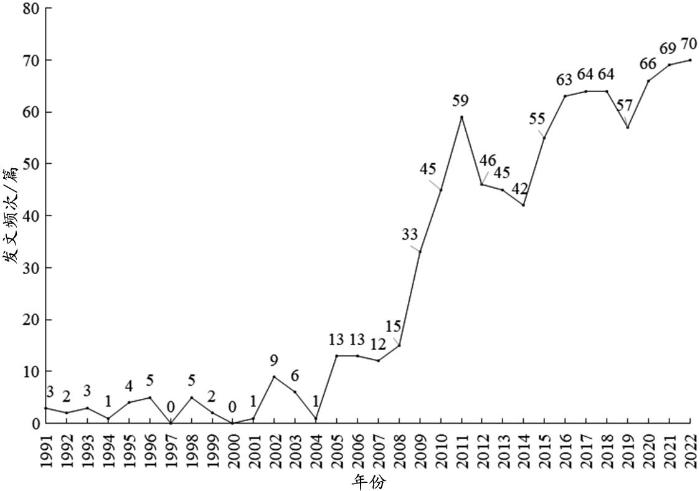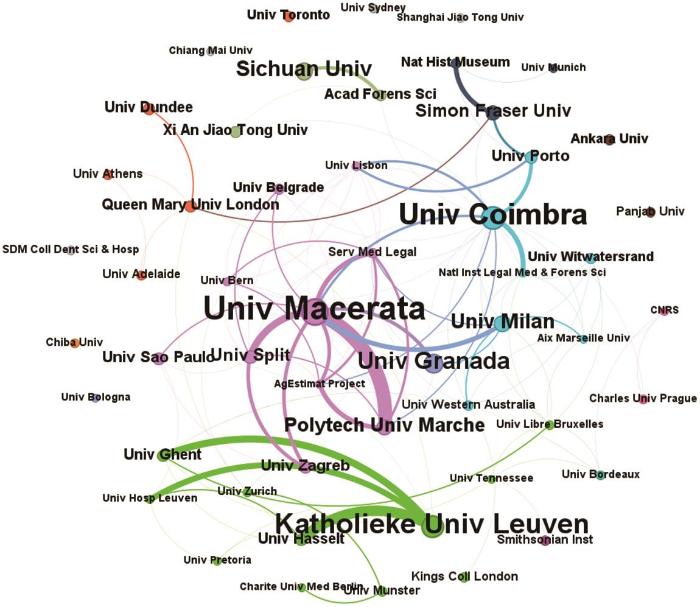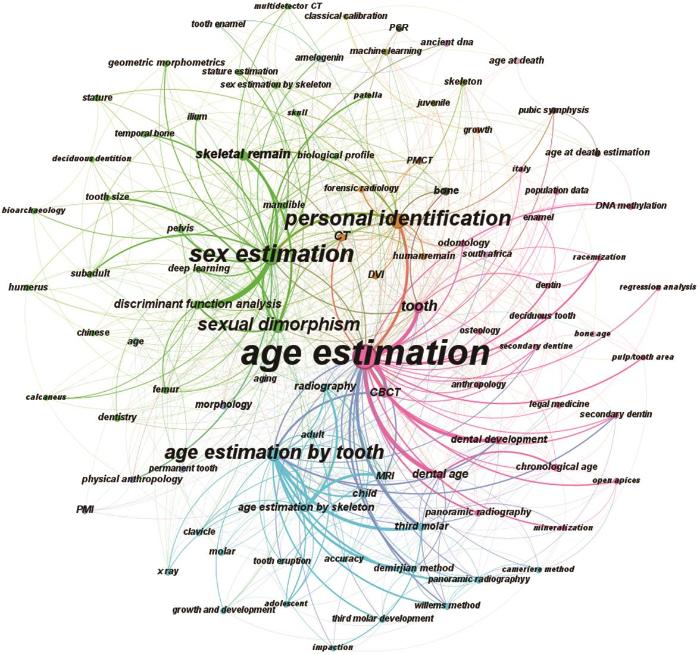近年来,随着法医人类学技术的不断进步和广泛应用,遗骸识别的研究也取得了显著进展。本研究基于WoSCC和可视化分析软件Gephi,引入网络分析中的中介中心性(betweenness centrality,BC)和特征向量中心性(eigenvector centrality,EC)对1991—2022年法医人类学中遗骸识别研究的现状、热点、演进历程进行系统分析,为从事相关研究的学者提供参考。
1 材料与方法
1.1 数据来源
于WoSCC中检索与法医人类学遗骸识别相关的文献,检索词由法医人类学领域专家推荐,将医学主题词(medical subject headings,MeSH;
于2023年2月15日创建检索式,关键词为“skeleton、remain、teeth、buried、sex、age和disaster victim identification(DVI)”,“data range”为1991—2022年,“Document Types”选择为“Article”。共收集到1 812篇文献,并将其导出为“.xls”格式。
1.2 数据处理与清洗
1.2.1 数据处理
删除5篇重复的文献和88篇提前发表的文献,即发表时间标记为2023年的文献。
两位有经验的法医人类学专家分别阅读1 719篇文献的文题、关键词和摘要后,标记是否为相关文献,并由第三位有经验的法医人类学专家对前两位专家标记的文献进行核对。对于那些标记不一致的文献,由三位专家再次仔细核查。如果三位专家中有至少两位一致认为该文献涉及法医人类学遗骸相关研究内容,那么该文献被纳入本研究范围。此步骤共删除846篇无关文献。最后纳入本研究的文献有873篇。
1.2.2 数据清洗
使用python 3.9.2软件(
1.2.2.1 国家(地区)
采用“Addresses”字段进行分析,对于只提供地区或省市信息的数据,将其全部替换为对应国家(地区)的名称,如将“FOUNTAIN VALLEY”清洗为“USA”、“Taiwan”清洗为“China”。统一将国家(地区)的名称改为首字母大写,如“POLAND”清洗为“Poland”。
1.2.2.2 作者和机构
“Addresses”字段机构缺失者,使用“Reprint Addresses”中的信息补全,如将“LMU”替换为“Ludwig Maximilians Univ Munchen”。根据机构将相似的作者缩写统一。
1.2.2.3 关键词
优先采用“Author Keywords”进行分析,如有缺失,则根据“Keywords Plus”、文献文题和摘要对关键词进行补充。清洗原则:①统一使用最常用的同义词,如将“age determination by skeleton”“age determination from skeletons”“age determined by the skeleton”和“age estimation from skeleton”等表达方式统一为“age estimation by skeleton”;②使用单数形式,如将“teeth”改为“tooth”;③如果出现全拼与缩写两种方式表达专有名词的情况,统一使用缩写进行表示,如将“Cone-Beam Computed Tomography”改为“CBCT”。
此外,由于关键词中的学科分类关键词在分析时会干扰聚类,故本研究根据情况剔除>50次的学科分类关键词后再进行分析。
1.3 数据分析
在本研究中,使用Gephi 0.10软件(
2 结果与讨论
2.1 发文情况
由发文频次及变化趋势(图1)可见,法医人类学遗骸识别研究大致可以分为起步探索(1991—2004年)、稳步提升(2005—2008年)和高速发展(2009—2022年) 3个阶段。起步探索阶段时间跨度长、相关文献数量少(共42篇),年均发文频次仅3.00篇;稳步提升阶段,发文频次逐渐增加(共53篇),年均发文频次为13.25篇,是起步探索阶段平均发文频次的4.42倍;高速发展阶段相关研究文献数量持续增长,累计发表778篇,年均发文频次为55.57篇,分别是起步探索阶段和稳步提升阶段的18.52倍和4.19倍。
图1
图1
1991—2022年法医人类学遗骸识别研究领域的发文频次
Fig. 1
Frequency of publications in the field of forensicanthropological remains identification researchfrom 1991 to 2022
2.2 文献来源
873篇文献来自159种期刊,发文频次排名前10位期刊(表1)的载文量约占总发文量的68.0%。以Forensic Science International载文量较多(164篇),American Journal of Physical Anthropology文献单篇被引频次最高(平均每篇41次),说明该两种期刊在法医人类学遗骸识别研究领域具有一定的权威性与代表性。
表1 1991—2022年法医人类学遗骸识别研究领域发文频次排名前10的期刊
Tab. 1
| 序号 | 期刊 | 类别 | 分区 | 排名 | 影响因子 | 文献数/篇 | 总被引频次 | 平均被引频次 |
|---|---|---|---|---|---|---|---|---|
| 1 | Forensic Science International | Medicine, Legal | Q1 | 6/24 | 2.2 | 164 | 4 366 | 26 |
| 2 | Journal of Forensic Sciences | Medicine, Legal | Q2 | 10/24 | 1.6 | 117 | 2 807 | 23 |
| 3 | International Journal of Legal Medicine | Medicine, Legal | Q1 | 3/24 | 2.1 | 110 | 2 209 | 20 |
| 4 | Journal of Forensic and Legal Medicine | Medicine, Legal | Q2 | 11/24 | 1.5 | 55 | 1 042 | 18 |
| 5 | American Journal of Physical Anthropology | Anthropology | Q1 | 31/137 | 2.8 | 43 | 1 774 | 41 |
| Evolutionary Biology | Q3 | 14/55 | ||||||
| 6 | Legal Medicine | Medicine, Legal | Q3 | 14/24 | 1.5 | 33 | 338 | 10 |
| 7 | Australian Journal of Forensic Sciences | Medicine, Legal | Q3 | 15/24 | 1.0 | 23 | 120 | 5 |
| 8 | Rechtsmedizin | Medicine, Legal | Q4 | 19/24 | 0.5 | 20 | 222 | 11 |
| 9 | Journal of Archaeological Science | Anthropology | Q1 | 11/137 | 2.8 | 16 | 524 | 32 |
| Archaeology | Q1 | 10/161 | ||||||
| Geosciences, Multidisciplinary | Q1 | 10/249 | ||||||
| 10 | Forensic Science Medicine and Pathology | Medicine, Legal | Q3 | 13/24 | 1.8 | 13 | 91 | 7 |
| Pathology | Q2 | 41/87 |
PSA最低的5篇文献(表2)中,牙齿研究占了4篇,其中International Journal of Environmental Research and Public Health和Journal of Pharmaceutical Negative Results两种期刊各有2篇,第一作者为印度籍的有2篇。
表2 1991—2022年法医人类学遗骸识别研究领域PSA最低的5篇文献
Tab. 2
| 序号 | 文题 | 来源期刊 | 第一作者所属国家 | PSA |
|---|---|---|---|---|
| 1 | Evaluation of a Machine Learning Algorithms for Predicting the Dental Age of Adolescent Based on Different Preprocessing Methods | Frontiers in Public Health | 中国 | 0.001 5 |
| 2 | Age Estimation Using Maxillary Central Incisor Analysis on Cone Beam Computed Tomography Human Images | International Journal of Environmental Research and Public Health | 西班牙 | 0.001 5 |
| 3 | Adapting Demirjian Standards for Portuguese and Spanish Children and Adolescents | International Journal of Environmental Research and Public Health | 葡萄牙 | 0.001 5 |
| 4 | Age and Sex Determination Using CT Scan Nasal Bone Imaging | Journal of Pharmaceutical Negative Results | 印度 | 0.001 8 |
| 5 | Age Estimation in Indian Population by Kvaal’s Method Using Maxillary Canine | Journal of Pharmaceutical Negative Results | 印度 | 0.001 8 |
2.3 国家(地区)
本研究中,作者来自77个国家(地区),按发文频次从高到低排名前5的依次为中国(90篇)、美国(75篇)、意大利(50篇)、德国(49篇)和印度(44篇)。发文频次≥3次的国家(地区)共现网络分析结果(图2)显示,43个国家(地区)被分成6组,其中协作国家(地区)最多的3个群体依次为中国协作群[31个国家(地区),累计发文频次415次]、意大利协作群[31个国家(地区),累计发文频次310次]和英国协作群[10个国家(地区),累计发文频次112次],3个协作群的国家(地区)总发文频次占所有频次的95.88%,说明这3个协作群在法医人类学遗骸识别领域方面的研究占主导地位。
图2
图2
1991—2022年法医人类学遗骸识别研究领域的文献作者国家(地区)共现网络图
以发文频次≥3次对共现网络进行剪枝;点的大小表示国家作者的发文频次,点和边的颜色表示模块(聚类),边的粗细表示共现次数。
Fig. 2
Co-occurrence network diagram of author countries(regions) in the field of forensic anthropological remainsidentification research from 1991 to 2022
国家(地区)的热力图(附图1)显示,1991—2004年,相关研究主要集中在美国、加拿大和德国;2005年及以后,开展研究的国家(地区)开始逐渐增多,如中国、意大利和印度。虽然印度在法医人类学遗骸识别上的研究起步较晚,但是从2009年开始,相关研究文献数量呈增多趋势,累计发文量为44篇,排名第5位。
协作国家(地区)最多的3个协作群的散点图(附图2)显示,美国位于图的右上角,远离其他国家,表明其在该领域的综合研究实力较强。另外,在发文频次方面,中国排名第1位,EC值为0.524 6,排名第15位,BC值为32.432 1,排名第5位,说明中国在法医人类学遗骸识别领域的研究具有一定的影响力和地位,但在国际合作方面还有较大的发展空间。
2.4 发文机构
本研究中,作者来自480家机构,发文频次≥10次的7家机构见表3。其中,Univ Macerata虽然发文量不高,但是总被引频次却很高,查看其发表的文献后发现,12篇文献中有7篇被引频次超过30次,说明Univ Macerata机构在人类遗骸识别领域中影响力颇高。以发文频次≥5次剪枝后的发文机构共现网络图(图3)显示,45家发文机构被分成18组,每组以发文频次最多的机构进行命名,其中协作机构最多的3个群体依次为Katholieke Univ Leuven协作群(16家机构,累计发文频次129次)、Univ Macerata协作群(11家机构,累计发文频次132次)和Univ Coimbra协作群(9家机构,累计发文频次100次),对这3个协作群的发文机构进行分析,发现这3个群体的论文总发文频次占整体研究领域的41.35%。这表明法医人类学遗骸识别领域的研究在各个机构之间均有涉及,不存在某一家机构主导的情况。此发现强调了该领域研究的广泛参与性和多元性,各机构在法医人类学遗骸识别方面都积极投入,并为该领域的综合发展作出了贡献。
表3 1991—2022年法医人类学遗骸识别研究领域发文频次≥10次的机构
Tab. 3
| 排名 | 机构 | 国家 | 发文频次 | 总被引频次 |
|---|---|---|---|---|
| 1 | Katholieke Univ Leuven | 荷兰 | 21 | 568 |
| 2 | Sichuan Univ | 中国 | 19 | 278 |
| 3 | Univ Coimbra | 葡萄牙 | 16 | 282 |
| 4 | Univ Granada | 西班牙 | 15 | 351 |
| 5 | Univ Milan | 意大利 | 13 | 295 |
| 6 | Univ Macerata | 意大利 | 12 | 398 |
| 7 | Xi An Jiao Tong Univ | 中国 | 10 | 192 |
图3
图3
1991—2022年法医人类学遗骸识别研究领域的文献发文机构共现网络图
以机构发文频次≥5次对共现网络进行剪枝;点的大小表示机构的发文频次,点和边的颜色表示模块(聚类),边的粗细表示共现次数。
Fig. 3
Co-occurrence network diagram of literature issuinginstitutions in the field of forensic anthropological remainsidentification research from 1991 to 2022
发文频次排名前5协作群的散点图(附图3)显示,Univ Coimbra虽然发文频次为16次,但其EC值和BC值最大,位于散点图的右上方,说明其在该领域的影响力较高,在研究中起到关键的枢纽作用。来自中国的Xi An Jiao Tong Univ EC值为0.070 7(排名第26位)、BC值为14 879.042 8(排名第12位),Sichuan Univ EC值为0.013 8(排名第39位)、BC值为11 523.500 0(排名第15位),Academic Forensic Sci EC值为0.060 8(排名第29位)、BC值为23 279.500 0(排名第6位),说明我国在这方面的研究影响力和国际合作之间均有较大的提升空间。
2.5 作者
873篇文献由3 136位作者完成,平均每篇文献署名3位作者。以发文频次≥5次进行剪枝后的作者协作网络显示,51位作者被分为19个协作群(图4)。值得注意的是,有3个研究团队累计发文频次超过15次,分别为CAMERIERE R团队、FIEUWS S团队和DENG Z H团队,其中CAMERIERE R和FIEUWS S团队主要进行牙齿年龄推断,DENG Z H团队的主要研究内容是通过CT、MRI和深度学习等技术进行性别和年龄推断。
图4
图4
1991—2022年法医人类学遗骸识别研究领域的文献作者共现网络图
以作者发文频次≥5次对共现网络进行剪枝;点的大小表示作者的发文频次,点和边的颜色表示模块(聚类),边的粗细表示共现次数。
Fig. 4
Co-occurrence network diagram of authorsin the field of forensic anthropological remainsidentification research from 1991 to 2022
2.6 主题词分析
关键词是文献主要内容的提炼和概括,其频次可反映研究热点及发展方向[16]。本研究共得到1 996个关键词,频次排名前10的关键词见表4,可以看出人类遗骸研究的热点是遗骸的性别鉴定和年龄推断,并且常用的遗骸是牙齿。剔除频次>50次的学科分类关键词,以频次≥6次对关键词的共现网络进行剪枝(图5),结果显示,关键词被分为55组,每组以频次最高的关键词命名,累计频次排名前3的分别为age estimation(年龄推断)组(505次,24个关键词)、sex estimation(性别推断)组(442次,26个关键词)和age estimation by tooth(牙龄推断)组(112次,20个关键词)。
表4 1991—2022年法医人类学遗骸识别研究领域排名前10的关键词
Tab. 4
| 序号 | 关键词 | 出现 频次 |
|---|---|---|
| 1 | age estimation(年龄推断) | 262 |
| 2 | forensic(法医学) | 198 |
| 3 | forensic anthropology(法医人类学) | 172 |
| 4 | forensic dentistry(法医齿科学) | 142 |
| 5 | sex identification(性别鉴定) | 135 |
| 6 | age estimation by tooth(根据牙齿推断年龄) | 112 |
| 7 | personal identification(识别) | 86 |
| 8 | sexual dimorphism(性二态) | 66 |
| 9 | human remain(人体遗骸) | 54 |
| 10 | forensic anthropology population data(法医人类学人口数据) | 50 |
图5
图5
1991—2022年法医人类学遗骸识别研究领域的文献关键词共现网络图
以关键词频次≥6次对共现网络进行剪枝;点的大小表示作者的发文频次,点和边的颜色表示模块(聚类),边的粗细表示共现次数。
Fig. 5
Co-occurrence network diagram of keywordsin the field of forensic anthropological remainsidentification research from 1991 to 2022
结合关键词频次≥6次的时序性变化热力图(附图4)可以发现,性别鉴定和年龄推断自本研究起始年度1991年起就是两个重要的研究主题,并且持续受到关注和研究。
2.6.1 性别鉴定
从关键词可见,常用的遗骸有pelvis(骨盆,12次)、mandible(下颌骨,11次)、clavicle(锁骨,8次)、temporal bone(颞骨,8次)和skull(颅骨,7次)等;常用的方法有discriminant function analysis(函数判别分析方法,31次)、deep learning(深度学习,15次)、machine learning(机器学习,12次)和geometric morphometrics(几何形态测量法,10次)等。
2007年,法国专家第一次使用多层计算机断层扫描(multislice computed tomography,MSCT)对烧焦的尸体进行个体识别[25]。虚拟人类学具有非侵入性、非破坏性,可便捷、快速地进行个体识别。因此,基于虚拟人类学建立符合各国人群骨骼遗骸形态特征、更为客观稳定且简易的性别推断方法具有重要实际意义。自2009年起,与虚拟人类学相关的文献数量逐渐增多,反映了对这一领域的日益关注。2019年,机器学习和深度学习开始应用于法医人类学遗骸识别研究领域,其具有海量的数字化数据,计算机强大的计算能力以及先进的算法都使得深度学习技术在复杂的视觉识别任务中取得了显著成果,其在特定视觉识别任务上能够媲美甚至超越人类专家。CAO等[26]将深度学习技术与光学三维扫描技术相结合,探究了对法医学现场发现的骨骼遗骸进行即时性别推断的可行性。
2.6.2 年龄推断
从关键词可见,常用的遗骸有tooth(牙齿,38次)和third molar(第三磨牙,29次),常用的方法有CBCT(牙齿锥形束计算机断层扫描,33次)、Demirjian method(Demirjian法,20次)、Willems method(Willems法,16次)。
在对遗骸的研究中,牙齿占据着不可或缺的地位。牙齿是人体最坚硬的器官之一,其抗腐蚀能力强,多项形态特征具有增龄性变化,因此利用牙齿推断年龄在法医学中得到广泛应用。在众多牙龄推断法中,被广为接受的是Demirjian法[27]。1973年,DEMIRJIAN等[28]对牙齿成熟度和钙化程度进行分期(A~H),在转化为相应的牙龄成熟度指数后查表获得结果。2001年,WILLEMS[29]对高加索人种进行研究,改进了Demirjian法,建立的Willems法更加简洁易懂。2006年,CAMERIERE等[30]通过对455例意大利儿童左下颌7颗恒牙根尖孔闭合情况进行定量估计,得到牙龄推断的多元线性回归方程,建立了Cameriere法。牙齿CBCT在口腔领域的应用,为牙齿三维影像的获得提供了新的途径。YANG等[31]从19例个体(23~70岁)中选择了28个CBCT的牙齿影像(包括15个中切牙、12个尖牙和1个前磨牙),测量牙髓与牙体的容积比,结果显示,牙髓与牙体容积比与个体年龄有相关性,可以用来推断年龄。随着CBCT技术的发展和应用,其为法医齿科学提供了一种强大的工具,能够更准确、全面地评估遗骸的年龄。
阅读相关文献时还发现,NAVEGA等[32]将深度学习与骨密度推断年龄的方法相结合,探究了骨密度测量法,即双能X射线吸收法(dual-energy X-ray absorptiometry,DXA)对年龄推断的可行性。机器学习与深度学习作为新技术,也将为遗骸的年龄推断提供更多可能性。
从1991年到2022年,人类遗骸识别研究呈现持续稳步上升的趋势,反映了对这一领域的不断深入关注和研究。本研究显示了人类遗骸识别在法医人类学身份确认方面的重要性,并揭示了性别和年龄推断在该领域中的具体应用。骨盆、颅骨和牙齿等骨骼结构一直以来在法医人类学遗骸识别领域占据着重要地位,为个体识别提供了关键信息。
本研究采用文献计量学方法对法医人类学遗骸识别的发展和趋势进行了分析。虽然文献计量分析较为全面和客观,但和以往的研究一样,仍然存在一些局限性[33]。本研究只从WoSCC数据库中提取了有关法医人类学遗骸识别的相关文献。尽管WoSCC是最常用、最权威的综合数据库之一,但仍有部分出版物未被收录。随着科技的飞速发展,未来的研究方向将逐渐聚焦于引入机器学习和深度学习等先进技术,提高各类骨骼遗骸个体识别的精准度和效率。
参考文献
A history of forensic anthropo-logy
[J].
青少年牙槽骨吸收高度与性别、年龄的关系
[J].
Relationship between the height of alveolar bone resorption and sex and age in adolescents
[J].
Methods of forensic facial reconstruction and human identification: Historical background, significance, and limitations
[J].
1991—2020年法医学溺死领域中英文文献计量学分析
[J].
Bibliometrics analysis in English and Chinese literature on drowning in forensic medicine from 1991 to 2020
[J].
How to rank journals
[J].
COVID-19 enabled co-authoring networks: A country-case analysis
[J].
A probabilistic model for co-occurrence analysis in bibliometrics
[J].
Trends in sigma-1 receptor research: A 25-year bibliometric analysis
[J].
2019
.
Recent trend and perspectives in forensic anthropology: A bibliometric analysis
[J].
Worldwide tendency and focused research in forensic anthro-pology: A bibliometric analysis of decade (2008—2017)
[J].
A construction and empirical research of the journal disruption index based on open citation data
[J].
Higher-order aggregate networks in the analysis of temporal networks: Path structures and centralities
[J].
Centralities in simplicial complexes. Applications to protein interaction networks
[J].
2017
.
Analysis on causes of chemical industry accident from 2015 to 2020 in Chinese mainland: A complex network theory approach
[J].
ForceAtlas2, a continuous graph layout algorithm for handy network visualization designed for the Gephi software
[J].
pone
.
A critical review of the development, current hotspots, and future directions of Lake Taihu research from the bibliometrics perspective
[J].
Functional aspects of pelvic morphology in Simian Primates
[J].
Sex determination from the foramen magnum: Discriminant function analysis in an eighteenth and nineteenth century British sample
[J].
Determining the sex of human remains through cranial morphology
[J].
A newly developed visual method of sexing the os pubis
[J].
Comparative analysis of four morphometric methods for sex estimation: A study conducted on human skulls
[J].
Evaluating intuitive decision-making in non-metric sex estimation from the cranium: An exploratory study
[J].
Estimation of stature and sex from sacrum and coccyx measurements by multidetector computed tomography in Chinese
[J].
Sexing skulls using discriminant function analysis of visually assessed traits
[J].
Virtual anthropology and forensic identification: Report of one case
[J].
A potential method for sex estimation of human skeletons using deep learning and three-dimensional surface scanning
[J].
利用牙齿推断年龄的研究进展
[J].
Recent progresses on dental age estimation
[J].
A new system of dental age assessment
[J].
A review of the most commonly used dental age estimation techniques
[J].
Age estimation in children by measurement of open apices in teeth
[J].
Dental age estimation through volume matching of teeth imaged by cone-beam CT
[J].
DXAGE: A new method for age at death estimation based on femoral bone mineral density and artificial neural networks
[J].
Bibliometric and visualized analysis of ocular drug delivery from 2001 to 2020
[J].








